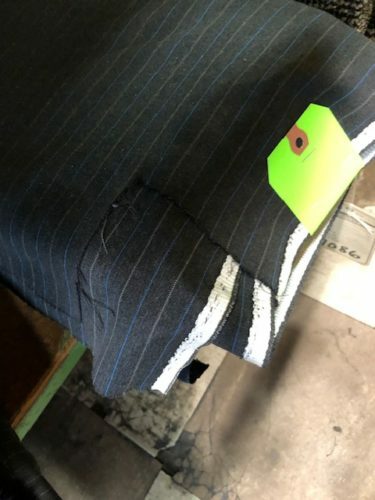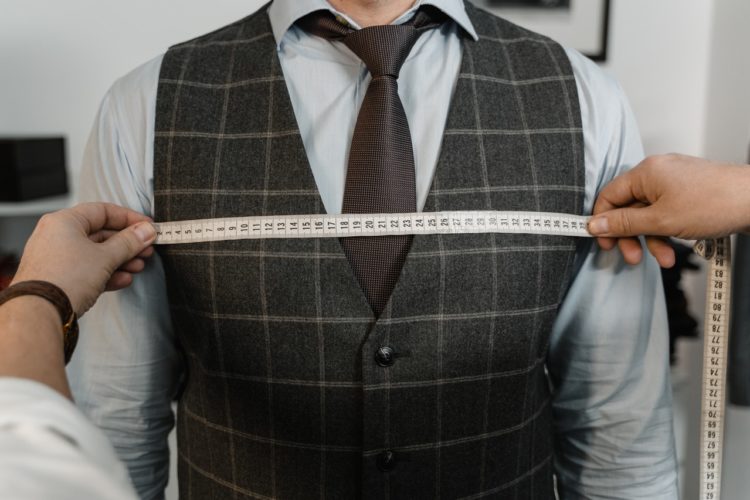In the last few years, there has been a resurgence in men’s finer fashion, and corollary to that, a string of stores and services that offer custom suits for reasonable – indeed, outrageously low, if you know suits – prices. Names like Tom James, Indochino, and Alton Lane quickly come to mind, and I can begin to list all of the options available online. These stores, and the options they offer, need to be discussed, even though doing so walks a fine line.
The prices are good, but one must take into account the reasons for this, and moreover, do a little backward math to figure out quality. I stopped by one of these stores, local to me, to check out their offerings, and their prices. Theirs ranged from $449 to $549, and indeed, they were having no less than a $50 off sale! $399-$499 for a custom-made two-piece suit. Surely, this must be a dream, right? Every man can have a high-quality, perfect-fitting, custom made suit, at a reasonable price! Well… slow down a little bit.
Are you getting a custom-made suit? Sort of. It falls back to the semi-custom category; custom and semi-custom can be hard to understand, but custom is, from the first stitch, completely new, tailored to you, and not based off of any preset templates. Semi-custom will start from a set of preset templates – though the offerings are likely to be quite broad – and extensively customized from there. Think designing your own house from the ground up, from scratch, off of any idea you’ve had, as opposed to taking a set of existing blueprints and making a ton of changes to them to make them unique.
As for high quality or perfect fitting? This is where we stumble. The way that these stores work, generally speaking, is that the local store, boutique, et al, will measure you – be it by hand or machine – and ‘lock down your fit’. Then you will pick your fabrics from their selections, pick your options, such as lining, pockets, buttons, embroidering, and so on, and then you’re done on your end. The process moves forward out of your sight.
Your information and order is forwarded to their partner manufacturer for the suits themselves, almost always in China. There, the process of building your suit takes place, in a factory alongside dozens or hundreds of others. Machines do the largest share of the work, with only minimal hand-finishing occurring; after all, even with the manufacturing occurring off-shore, costs must be controlled. The manufacturing process takes weeks, and then once your suit, and enough others, are finished, they are shipped together to the US, where the shipment will be broken down, and then your suit forwarded to the local shop.
Now, you reenter the process. You get the call from the local shop that your suit has arrived; excited, you go to try it on, and almost certainly find out that it… doesn’t fit quite right. No problem, you’re told (so long as it isn’t terribly off), after all, they expect to have to do some additional tailoring to get things perfect! So they check what doesn’t fit, what is too long and too short, what needs to be taken in and let out, and then you wait again while they further adjust your (semi)custom suit.
When all of this process is completed, two months or so, at least, have passed, and you have a suit that, hopefully, fits you fairly well. Unfortunately, speaking from first-hand experience, that hope may be unfounded, as the fit can end up being more hype and less hope, and sadly, a lot of reviews of these vendors seem to sync with that same experience. But perhaps things go well, and you have a semi-custom suit that fits you well. What about quality?
Therein lies the rub, and where, as I said, we have to do a little bit of math. This is all rough and hypothetical, but should give you an idea where you’re at. Let’s say you get a $499 suit, rounding to $500. First, remember that nice, upscale shop you visited? They have to pay rent on that, of course. And pay the multiple staff members there. Let’s be conservative and say that that accounts for $75 from the price of your suit. Okay, well, your suit is worth $425. But they have to pay the offshore workers who make the suit, as well as the supervisors, payments for and maintenance on the machinery, etc. Another $50, easily. You’re down to $375. But of course, the offshore manufacturer isn’t making the suits out of generosity, they have to make a profit, so that’s another $50. $325. There’s taxes that the business has to pay (sometimes called embedded tax), as well as tariffs on the suit when imported to the US, business insurance, and regulatory costs. $75, so now you’re $250. Oof! Oh, and I almost forgot… the company has to make a profit, of course. $175.
 If you’re following the math, that leaves $75 to go toward the materials of your suit. The fabric, the lining, the buttons, the thread, the canvas, all of it. If you’re wondering if that’s reasonable, decent – not even fantastic, but decent – suit fabric from a reputable mill runs about $350-$400. Just for the fabric. And that’s for wool, which, while it is the gold standard for making suits, doesn’t account for silk blends, cashmere, linen, etc. Special blends add special prices. Getting into higher-end fabrics, with higher thread counts, and/or better mills, fabric alone can stretch to close to $1,000.
If you’re following the math, that leaves $75 to go toward the materials of your suit. The fabric, the lining, the buttons, the thread, the canvas, all of it. If you’re wondering if that’s reasonable, decent – not even fantastic, but decent – suit fabric from a reputable mill runs about $350-$400. Just for the fabric. And that’s for wool, which, while it is the gold standard for making suits, doesn’t account for silk blends, cashmere, linen, etc. Special blends add special prices. Getting into higher-end fabrics, with higher thread counts, and/or better mills, fabric alone can stretch to close to $1,000.
All of this is to say that you have to be honest with yourself about these shops. They offer a service, and if you are not interested in level of quality or longevity or real image, they might be an ideal choice for you. Do not, though, let them convince you that they offer a viable alternative to a true custom or semi-custom suiting experience. They are more or less trying to mimic this experience, echo it, cheaply. Think video game sailing versus actually being on a boat.
As for the online versions of these stores? The process works much the same, only you have to provide your measurements yourself, which any tailor will tell you – not just those trying to sell you something – is a risky proposition. Taking measurements is actually not nearly as simple as it seems, and it is nigh impossible to take your own. So, while prices are likely lower, you’re looking at a situation where the store and on-site staff expenses are gone, but you’ve added online sales expenses, higher margins for waste due to returns and remaking items as a result of inaccurate measurements, marketing and PR to keep their names high on search engine results, and potentially a whole new line item – contracted tailoring services. After all, they are an online service, who are they going to have do the ‘final touches’ to correct errors when the suit gets to you?
Is all of this to insult or degrade these stores? Hardly, they have their place in the market, to be sure. As well, their help in driving the improvement, or at least restoration, of men’s fashion, cannot be denied. But Well Sewn is not here to help our readers achieve just convenience, or just inexpensiveness. We strive to help readers find that point where they are maximizing your return on investment, getting the best quality for your money without hitting diminishing returns, and sadly, these stores are nowhere near the top of that curve.
Do not, however, lose hope. As I said before, there are options, but it may not be where you have considered.



